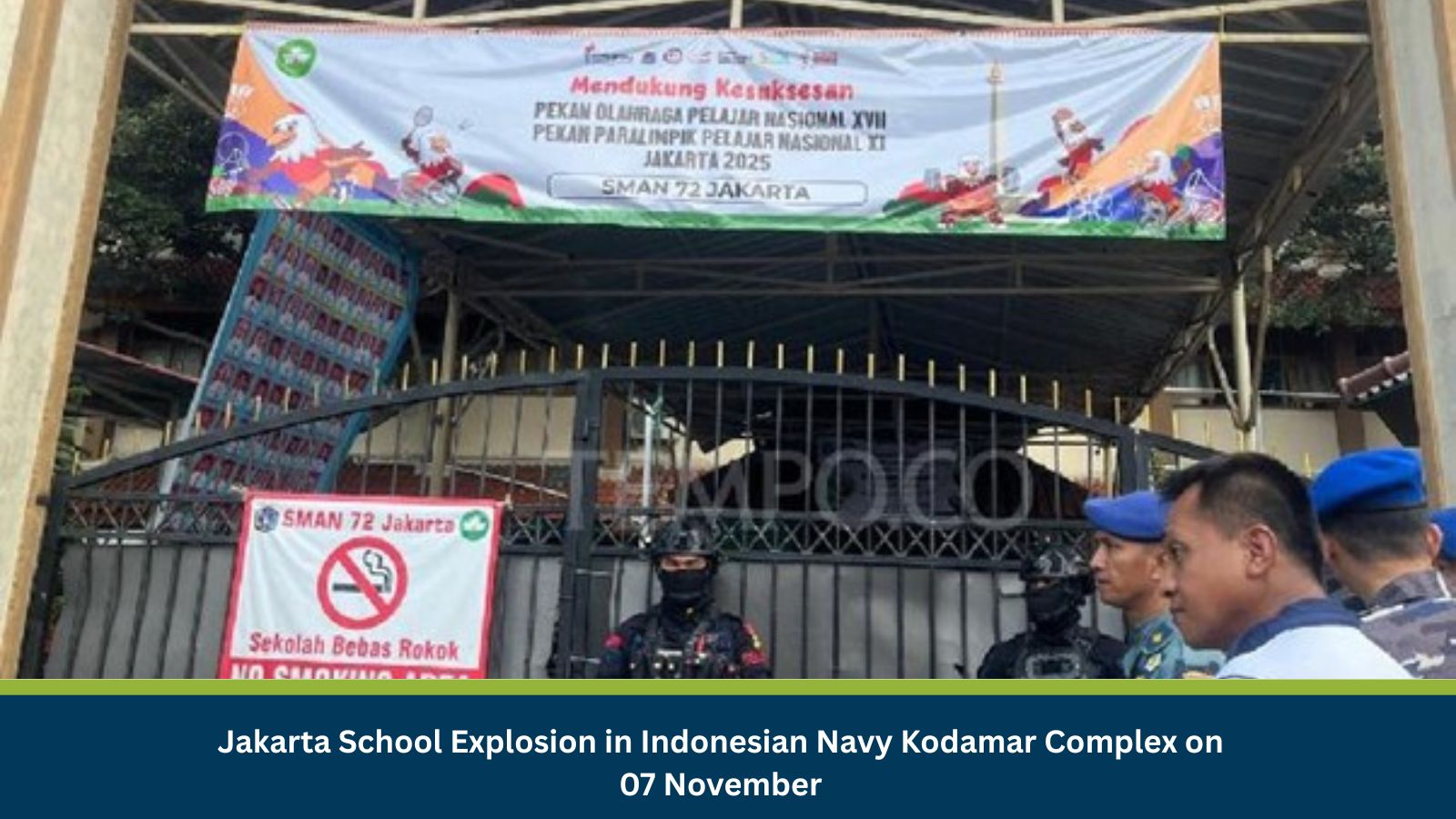What Is Risk Analysis in the Context of Urban Safety Incidents
Urban-safety risk analysis assesses how localized explosions, fires, or hazardous-material incidents affect public safety, mobility, and operational continuity in dense city environments. In North Jakarta, where educational and military facilities are situated close to residential zones, such incidents carry heightened social sensitivity.
The 07 November explosion at SMAN 72 Jakarta, located near the Indonesian Navy’s Kodamar Complex, underscores vulnerabilities in chemical handling, emergency readiness, and urban coordination systems. While preliminary findings indicate an accidental cause, the event highlights recurring safety lapses in institutional facilities with limited hazardous-material oversight.
Executive Summary
- Date of Event: 07 November 2025
- Location: Jakarta, Indonesia
- Risk Category: Civil Disturbance
- Severity Score: 4 / 5
- Confidence Level: 90 %
An explosion occurred at SMAN 72 Jakarta, injuring 54 people, including 3 seriously and 10 students hospitalized. Initial reports suggest the involvement of chemical materials, causing a pungent odor after the blast. Emergency services, including BPBD Jakarta and Polda Metro Jaya, have secured the area and commenced a detailed investigation.
While the incident appears localized, the casualty scale and proximity to both residential blocks and the naval facility have amplified community concern.
Known Hotspots and Sensitive Areas
- High Impact: SMAN 72 Jakarta, Jl. Bendungan Melayu No. 19 (blast site and immediate radius).
- Medium Impact: Residential clusters and local shops along Semper Barat and Cilincing roads.
- Low Impact: Peripheral districts of Koja and Tanjung Priok, with mild traffic spillover.
Schools, naval installations, and nearby government offices have heightened perimeter controls as a precautionary measure.
Impact on Infrastructure and Services
- Casualties: 54 injured, 3 in critical condition; majority are students and teaching staff.
- Traffic and Mobility: Jl. Bendungan Melayu closed for emergency and investigation teams; diversions via Jl. Raya Cilincing.
- Environmental Impact: Chemical odor indicates minor hazardous-material release, contained within 100 m radius.
- Utilities: Localized disruption to power and water lines inside the school compound; no wider outage reported.
- Emergency Operations: Ongoing site containment and forensic analysis may continue for 2–3 days.
Recommended Actions
- Employee Safety: Advise staff residing near Cilincing and Kodamar areas to avoid travel through affected roads; implement remote work or staggered schedules.
- Operational Readiness: Conduct facility-level safety audits, particularly in laboratories or chemical storage sites.
- Stakeholder Communication: Coordinate with BPBD Jakarta and Jakarta Education Department for verified updates; issue factual internal advisories to prevent misinformation.
- Continuity Planning: Map alternate logistics routes bypassing North Jakarta industrial corridors; test emergency response channels for urban incidents.
- Community Engagement: Facilitate post-incident counseling and public reassurance messaging to reduce anxiety and speculation.
Multidimensional Impact
The explosion adds to Jakarta’s ongoing strain from multiple concurrent challenges including recent Tangerang fires, tidal flood warnings, and weather modification operations placing emergency resources under pressure. Psychologically, the incident has deepened community anxiety due to its location within a school, reinforcing calls for tighter safety governance in public institutions. Economically, while direct disruption is localized, the broader administrative response and potential policy review may incur temporary administrative slowdowns. Environmental risk remains low, but recurring chemical-handling accidents could provoke new safety mandates across educational facilities.
Emergency Contacts
- Police: 110
- Fire Department: 113
- Ambulance: 118 / 119
- National Emergency: 112
- Polda Metro Jaya (Jakarta Police)
- Jakarta Provincial Government
- BMKG (Meteorology, Climatology, and Geophysics Agency)
Final Thoughts
The North Jakarta explosion on 07 November represents a high-severity but localized safety incident, drawing attention to chemical management and institutional preparedness in urban environments. While the immediate threat is contained, the scale of injuries and public visibility make this a critical test of Jakarta’s emergency coordination and communication efficiency. Organizations operating nearby should maintain situational monitoring, remote-work flexibility, and proactive communication with employees and local partners. Beyond short-term recovery, the incident serves as a reminder of the need for systemic safety audits across Indonesia’s educational and public-sector institutions to prevent recurrence. Stay ahead of operational risks with real-time alerts, scenario modeling, and expert advisories with datasurfr’s Predict. Start your 14-day free trial of Datasurfr’s Risk Intelligence Platform today.






